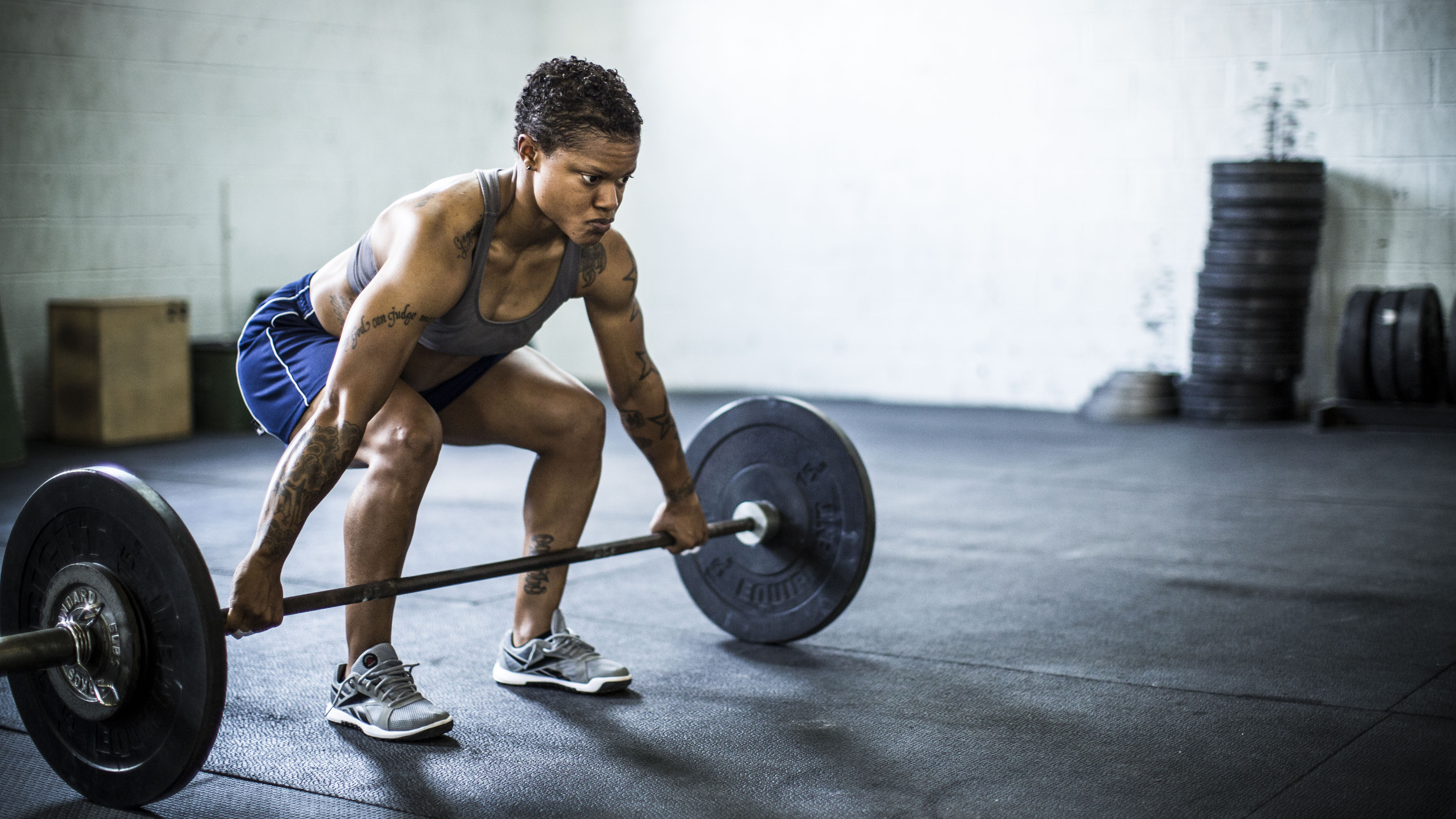What are the different muscle fiber types?
Muscle fiber types matter when it comes to sport and exercise – experts explain why

If your fitness goal is to up the ante on endurance, pack more power into your sprint, or supercharge your strength gains in the gym, it’s worth exploring – what are the different muscle fiber types?
The muscle fibers activated during training vary depending on the type of exercise or sport you’re undertaking, so swotting up on the different muscle fiber types, how they work, and why they matter for sports performance, could help you become a more effective athlete.
According to the Physical Therapy & Rehabilitation Journal, human skeletal muscle is composed of a collection of two muscle fiber types traditionally categorized as type I (slow-twitch) and type II (fast-twitch). Slow-twitch fibers are utilized for aerobic exercise, contracting slower and with less power, but for longer periods. Fast-twitch fibers contract faster and with more force, but are better suited to anaerobic conditions and short periods.
Find some of the best fitness trackers to power up your training motivation, or if it’s better muscular performance you’re after, you might love one of the best massage guns to relieve sore muscles.
We spoke to experts to learn more about muscle fiber types, how and when they activate during exercise, and how their efficiency can even be improved using sport and exercise training techniques. Read on to find out what our experts had to say.
What are muscle fibers?
Skeletal muscle within the muscular system is responsible for all human movement and controlled by your nervous system. “Muscle fibers are individual fibers that make up a muscle, and there are thousands within each,” explains Jeff Hoobler, head of coaching at Wahoo Sports Science. “Muscle fibers are organized into units called motor units, which consist of a motor neuron and all of the muscle fibers that it innervates.”

Jeff Hoobler is a cycling and strength coach with over 25 years of experience working with athletes of all levels from beginners to world champions. He has a degree in Sports Psychology and Exercise Science from the University of Kansas and is a Certified Strength and Conditioning Specialist through the National Strength and Conditioning Association. In addition, he is a MAT (Muscle Activation Techniques) therapist, Foundations Training Instructor, and USAC Level 3 Cycling coach.
Hoobler says each fiber also consists of smaller units called myofibrils which contain the contractile elements (proteins) called actin and myosin. All fibers contract the same way, but not all muscle fibers are the same. Muscles are made up of a mixture of fiber types and the predominant type is determined by the function of the muscle.
In simplest terms, the interaction of actin and myosin generates movement, but only in the presence of calcium. Calcium release triggers muscle contraction, but this can only happen after an electrical impulse from the nervous system. When the proteins interact, they can use ATP (a cellular energy source for muscle contraction) to convert this into movement.

Founder of Functional Medicine Associates (FMA), Pete Williams, M.Med.Sci CSCS - IFM certified practitioner, tells Live Science, “Skeletal muscle is a complex group of fibers that have different metabolic and functional properties. Although there is some debate in the research over the number of fiber types in skeletal muscle, two distinct fibers have been identified and classified by their ability to contract and the fuels they use to do this.”

Pete is an exercise and medical scientist and the founder of Functional Medicine Associates. In 2002 he was part of the UK’s founding group of Certified Strength and Conditioning Specialists, as accredited by the National Strength and Conditioning Association of America. In 2004 he became the youngest ever recipient of a ‘Lifetime Achievement’ award from the Register for Exercise Professionals. In 2013 he was in the first worldwide cohort to be awarded Institute for Functional Medicine Certified Practitioner status and has represented the Institute for Functional Medicine as a Clinical Innovator.
These two fibers are type I slow-twitch and type II fast-twitch fibers, but Hoobler explains that there are technically three classifications of muscle fibers – type I (slow oxidative), type IIA (fast oxidative), and type IIX (fast glycolytic). “Each of us has our unique blend of these types of muscle fibers that we’re born with, and unfortunately you're stuck with them. But the good news is that you can influence the development of each fiber type with training,” he says.
What are the different types of muscle fiber contraction?
Gregory Grosicki, Associate Professor of Kinesiology and director of Georgia Southern University Exercise Physiology Laboratory, says that muscle fibers can contract in three ways:
1. Shortening (concentric contraction)
2. Lengthening (eccentric contraction), or
3. Producing force without changing length (isometric contraction).
Slow-twitch and fast-twitch fibers contribute to movement, postural control, and different types of exercise output. According to research, including the aforementioned study above, muscle fibers have the potential to change in size (and in rare cases can convert from type IIX to IIA) in response to your training demands.

Greg Grosicki, Ph.D., CEP, currently serves as an assistant professor of kinesiology in the Department of Health Sciences and Kinesiology and as the director of the exercise physiology laboratory in the Biodynamics and Human Performance Center at Georgia Southern University Armstrong Campus. He earned a bachelor’s degree in kinesiology at The College of William and Mary, a master’s degree in health and exercise science at Wake Forest University and a doctorate in human bioenergetics in the Human Performance Laboratory at Ball State University.
What are type I (slow-twitch) muscle fibers?
Functional medicine expert Williams tells us that slow-twitch fibers have a much slower contraction speed than fast-twitch fibers and produce less powerful contractions. “However, they contain relatively large, and numerous, muscle cell power plants called mitochondria,” he says. “Mitochondria allow slow twitch fibers to be much more fatigue-resistant and well suited for prolonged aerobic exercise.”
Hoobler adds that these fatigue-resistant fibers don’t require much energy to produce tension either, which makes them excellent for supporting better posture, stabilizing joints, and pushing through low-intensity periods of endurance exercise (like marathons). “Type I fibers are always active, continuing to fire even as you lift something heavy or speed up your motion,” he says.

These muscle fibers are the first to be recruited as you exercise, but they’re smaller in size and produce less force (and with a slower contraction speed), so fast-twitch fibers will “take over” if exercise intensity requires them. Grosicki says slow-twitch fibers are more beneficial for endurance sports such as running and cycling, and you’ll also find them in abundance in regularly used muscles. For example, your diaphragm, heart, and lower calf muscles (soleus) consist almost entirely of slow-twitch fibers.
“These fibers primarily rely on oxygen to produce ATP (aerobic energy production),” Grosicki says. “But while this process is relatively slow, it can last a very long time. These fibers can still produce ATP without using oxygen (anaerobically) but they’re metabolically equipped to best produce ATP aerobically.
In short? Slow twitch fibers are the fibers most recruited in any aerobic exercise.
What are type II fast-twitch muscle fibers?
Fast-twitch fibers (IIA and IIX) recruit during powerful and explosive movements like sprinting, powerlifting, strength training, weight training, and basketball.
Rami Hashish, Ph.D., DPT, body performance & injury expert, explains that fast-twitch fibers exhibit fast and forceful contractions but fatigue more quickly. “Type IIA fibers are sometimes referred to as intermediate fibers, as they contract more quickly and forcefully than type I fibers, but less than IIX fibers.”

Rami Hashish obtained his PhD in biomechanics from the university of Southern California in 2014. He them worked as a clinical instructor of physical therapy for several years before founding the national biomechanics institute.
Head coach Hoobler adds that type IIA fibers can produce high tension but are also fatigue-resistant with proper training. “These fibers are oxidative (they produce ATP aerobically) and contain large amounts of mitochondria. These fibers will engage when type I fibers can no longer produce enough force or speed for the effort that you’re trying to make.
Type IIX fibers contract the fastest and produce the most tension and power but can’t sustain it for long, which is one reason you can’t run the same speed for 5km as you can for a 100m race.”
Williams clarifies further by explaining that fast-twitch fibers rapidly generate energy from sugars and generally don’t depend on oxygen for energy. It makes them readily available for quick and forceful contractions like sprinting and powerlifting.

“Power athletes have a higher ratio of fast-twitch fibers,” he says. “Sprinters have around 70-75% of type II, whereas endurance athletes exhibit more slow-twitch type I fibers. But we must remember muscle fiber is only one aspect of athletic success.”
Grosicki explains that type IIX fibers are the fastest and strongest fibers, often observed in high proportion in animals such as cats and cheetahs – less so in humans. While fast-twitch fibers rely more on anaerobic energy-producing pathways, they can still produce ATP using aerobic means.
In short, type IIA fibers can tap into aerobic and anaerobic energy systems, while type IIX fibers have the least oxidative capacity of all three and rely mostly on anaerobic metabolism.
How training affects muscle fiber types
Your nervous system is incredibly clever and can recruit the fibers you need depending on the exercise you’re performing and the effort required, defaulting between types I, IIA, and IIX as necessary. “It is the master of efficiency,” says Hoobler. “This is one reason why diversifying your training can help you become a more well-rounded athlete.”
Body performance expert Hashish says you can modify fiber type through exercise and training, with type I muscle fibers developing through endurance training and type II through strength training. “Recent scientific research has also shown that high-intensity interval endurance training could be an effective method for improving power,” he adds. A study in the Journal of Physiological Sciences found some evidence to support this.
According to Hoobler, the proportion of your fibers can vary dramatically and are determined by your genetics. He believes you can’t change one type of fiber into another, but you can train them to ‘act’ more like the other. “With the proper training stimulus, you can increase the power generated from slow twitch fibers just as you can improve the fatigue resistance of fast twitch fibers with endurance training,” he explains. “The key to success is understanding the hand you were dealt and making the most of it.”
Grosicki agrees that you can improve the efficiency of your fibers and their ability to adapt. “If you go from lots of endurance exercise to more strength or power training, your slow twitch fibers will likely become stronger, faster, and better at using anaerobic energy production, and vice versa,” he concludes.
Sign up for the Live Science daily newsletter now
Get the world’s most fascinating discoveries delivered straight to your inbox.

Sam Hopes is a level III fitness trainer, level II reiki practitioner, and resident fitness writer at Future PLC. Having trained to work with both the mind and body, Sam is a big advocate of using mindfulness techniques in sport and aims to bring mental wellbeing to the forefront of fitness. She’s also passionate about the fundamentals of training and how we can build more sustainable training methods. You’ll find her writing about the importance of habit-building, nutrition, sleep, recovery, and workouts.










